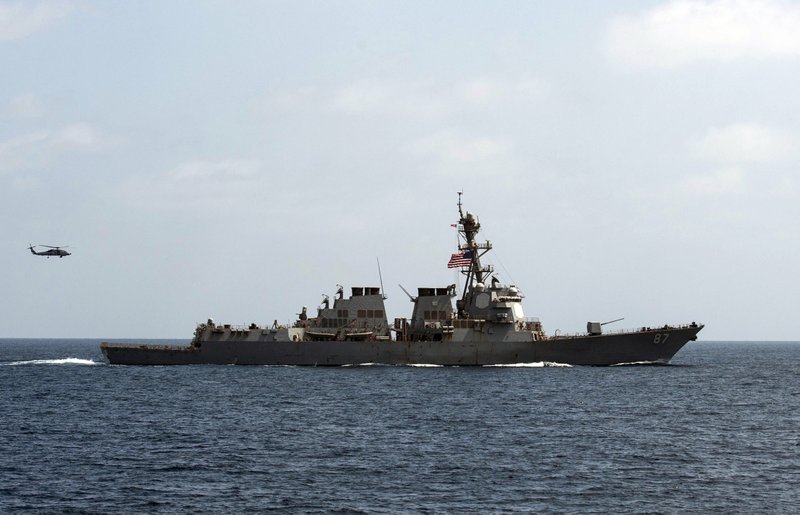Two missiles were fired from rebel-held territory in Yemen at a U.S. Navy ship in the Red Sea on Wednesday, marking the second time in four days that such an attack has occurred, defense officials said.
The U.S. responded early today by launching Tomahawk cruise missiles that destroyed three coastal radar sites in Houthi territory on Yemen's coast, American officials said.
A Pentagon spokesman said President Barack Obama authorized the strikes at the recommendation of Defense Secretary Ashton Carter and the chairman of the Joint Chiefs of Staff, Gen. Joseph Dunford.
Spokesman Peter Cook said in a statement that the U.S. actions were limited self-defense strikes conducted to protect personnel, ships and freedom of navigation.
The strikes came hours after missiles were fired at the USS Mason, a guided-missile destroyer that also came under fire Sunday night. The weapons were launched from an area of Yemen held by the Houthis, a rebel group that pushed the central government out of power in the capital city of Sanaa in 2014 and that has resisted U.S.-backed efforts by Saudi Arabia to restore Yemeni President Abed Rabbo Mansour Hadi to power.
An official said the USS Mason used countermeasures, but neither missile got near the ship and there were no injuries.
A second official said it wasn't clear whether the ship's countermeasures caused the missiles to hit the water on Wednesday or whether they would have landed there anyway.
The officials were not authorized to discuss the incident publicly, so they spoke on condition of anonymity.
The missiles fired Sunday were variants of the so-called Silkworm missile, and both fell harmlessly into the water. The Silkworm is a type of coastal-defense cruise missile that Iran has been known to use. Iran has backed the Shiite Houthi rebels.
On Sunday, two other missiles were launched from Yemen at the Mason and the USS Ponce, an amphibious ship used as a forward staging base. In that case, the first missile was launched while the ships were at least 12 miles away from Yemen's shore in international waters near the Bab el-Mandeb strait, a waterway between Yemen and Djibouti that is heavily trafficked by oilers.
Navy Capt. Jeff Davis, a Pentagon spokesman, told reporters Tuesday that the first missile was launched Sunday about 7 p.m. from a coastal area.
"We want very much to get to the bottom of what happened," Davis said. "Anybody who fires on U.S. Navy ships does so at peril to themselves."
A report from USNI News published Monday said the Mason fired at least three missiles in its defense: two Standard Missile-2s and an Enhanced Sea Sparrow Missile to intercept the one fired from Yemen. The outcome of those launches was not clear. The Mason also fired a Nulka anti-ship missile decoy, the report said. The decoys are designed to fool incoming missiles into believing there is another, larger ship to hit than the one targeted.
The missile launches from both sides come as the U.S. considers withdrawing its support for the Saudi-led coalition fighting the Houthis, after Saturday's airstrike on the funeral and other troubling instances of civilian casualties as a result of the Saudi bombing campaign.
Saturday's strikes killed more than 140 people and wounded hundreds more. Saudi officials have denied they carried out the attack, but two U.S. defense officials, who spoke on the condition of anonymity because of the sensitivity of the matter, said there is little reason to believe that.
President Barack Obama's administration said after the strikes on the funeral that they had "initiated an immediate review of our already significantly reduced support" to the Saudis and are "prepared to adjust our support so as to better align with U.S. principles, values and interests, including achieving an immediate and durable end to Yemen's tragic conflict."
A spokesman for U.S. Central Command, Army Maj. Josh Jacques, said late Tuesday that at that point, the military had not been directed to change any support in regard to Saudi Arabia. Refueling operations are carried out at the request of the Saudis, most recently on Sunday, outside Yemeni airspace, he said.
More than 4,000 civilians have been killed since the Saudis began launching airstrikes against the rebels in March 2015.
Information for this article was contributed by Dan Lamothe of The Washington Post and by Lolita C. Baldor of The Associated Press.
A Section on 10/13/2016
